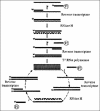Nucleic acid amplification: Alternative methods of polymerase chain reaction
- PMID: 24302831
- PMCID: PMC3831736
- DOI: 10.4103/0975-7406.120066
Nucleic acid amplification: Alternative methods of polymerase chain reaction
Abstract
Nucleic acid amplification is a valuable molecular tool not only in basic research but also in application oriented fields, such as clinical medicine development, infectious diseases diagnosis, gene cloning and industrial quality control. A comperehensive review of the literature on the principles, applications, challenges and prospects of different alternative methods of polymerase chain reaction (PCR) was performed. PCR was the first nucleic acid amplification method. With the advancement of research, a no of alternative nucleic acid amplification methods has been developed such as loop mediated isothermal amplification, nucleic acid sequence based amplification, strand displacement amplification, multiple displacement amplification. Most of the alternative methods are isothermal obviating the need for thermal cyclers. Though principles of most of the alternate methods are relatively complex than that of PCR, they offer better applicability and sensitivity in cases where PCR has limitations. Most of the alternate methods still have to prove themselves through extensive validation studies and are not available in commercial form; they pose the potentiality to be used as replacements of PCR. Continuous research is going on in different parts of the world to make these methods viable technically and economically.
Keywords: Amplification methods; ligase chain reaction; loop mediated isothermal amplification; multiple displacement amplification; nucleic acid sequence based amplification; polymerase chain reaction alternatives.
Conflict of interest statement
Figures








References
-
- Mullis KB. The unusual origin of the polymerase chain reaction. Sci Am. 1990;262:56–61, 64. - PubMed
-
- Fakruddin M. Loop mediated isothermal amplification-An alternative to polymerase chain reaction (PCR) Bang Res Pub J. 2011;5:425–39.
-
- Compton J. Nucleic acid sequence-based amplification. Nature. 1991;350:91–2. - PubMed
Publication types
LinkOut - more resources
Full Text Sources
Other Literature Sources

